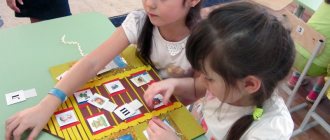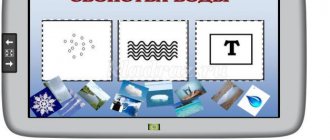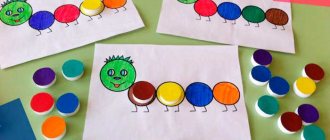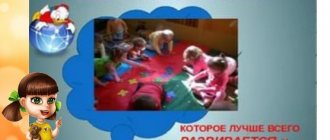Verbal and didactic games for children of the younger group of preschool educational institutions
Verbal and didactic games for children of primary preschool age in preschool educational institutions
Verbal and didactic game “Compare different animals” (2-3 years) Purpose : to teach children to compare different animals from fairy tales, highlighting the opposite characteristics. Number of players: 5-6 children Game rule: the child who is pointed to by the driver answers. Game action: The teacher invites the children to look at the Bear and the mouse. - The bear is big, and the mouse... (small). What kind of bear? (Thick, thick-footed, club-footed). What kind of mouse? (Small, grey, fast, dexterous.) What does Mishka like? (Honey, raspberries), and the mouse loves ... (cheese, crackers). — Mishka’s paws are thick, and the mouse’s…(thin). Who has the longest tail? The mouse has a long tail, and Mishka ... (short. Similarly, you can compare other animals from fairy tales - the fox and the hare, the wolf and the bear. Verbal and didactic game “Kids and the Bunny” Purpose: To teach children to come up with a new ending to a familiar fairy tale Number of players: 4-6 children Game rule: listen carefully to your interlocutor Game action: First, the children remember the fairy tale “The Little Goats and the Wolf". It can be recalled using a tabletop theater or a flannelograph. The fairy tale ends, but the teacher offers to listen to what happened next: “The goat went back to forest. The kids were left alone at home. Suddenly there was a knock on the door again. The kids got scared and hid. And it was a small... (the toy is shown) bunny. The bunny says: ...("Don't be afraid of me, it's me, the little bunny.") The kids... ( let the bunny in). They treated him...(cabbage, carrots). The kids ate and began... (play, have fun, frolic). The bunny played... (on the drum), and the kids... (jumped merrily). Verbal and didactic game “Chicken- Ryabushka” based on the fairy tale “Ryabushka Hen” Purpose: To develop speech activity in children, practice interrogative intonation with them, and train them in correct sound pronunciation. Number of players: a subgroup of children Game rules: the chicken must loudly and quickly answer the children’s questions Game action: the teacher shows a picture of a pockmarked hen, suggests remembering the fairy tale “Ryaba the Hen”. After telling the tale, he explains why it is called “Ryaba”. Then he invites the children to play. A chicken is chosen using a counting machine. The teacher puts a cap on her, puts her in front of the children and starts asking questions. The chicken answers them at the prompting of the teacher: - Chicken Ryaba, where did you go? - To the river. - Chicken Ryaba, why did you go? - For some water. - Chicken Ryaba, why do you need some water? - Water the chickens. - Chicken Ryaba, how do your chickens ask for water? - Pi-pi-pi-pi! (All children say this.) When playing the game again, the teacher suggests to the children: “Let’s all ask the chicken together where she went?” The children, together with the teacher, trying to reproduce a questioning intonation, ask: “Ryaba Hen, where did you go?” etc. It is better to choose shy, timid, silent children as chickens. 4. Printed board game “Paired Pictures” Purpose: To train children in comparing objects depicted in the picture, in finding similarities and in selecting identical images; cultivate attention, concentration, form speech, develop the ability to follow the rules of the game. Material: paired pictures-illustrations from Russian folk tales and chips Game rules: Show and name only the same picture; Whoever correctly selects and names the paired picture will receive a chip. Game action: searching for the necessary cards. Printed board game “Add a picture” Purpose: To train children in composing a whole object from its parts; cultivate will, perseverance, determination Number of players: Game rules: Don’t make a mistake in choosing. The one who folded and named his picture before the others wins. Game action: searching for parts, folding the whole picture. Printed board game “Loto” Purpose: To train children in the ability to combine objects according to their place of growth: where what grows; to consolidate children's knowledge about Russian folk tales Number of players: Game rules: cover the cells only with those pictures that correspond to the content of the large card, i.e. the fairy tale Game action: find small cards with images of episodes from fairy tales and cover the cells on the large map with them. Competition - who will be the first to cover all the cards Printed board game “Domino” (2-3 years) Purpose: To consolidate children’s knowledge about Russian folk tales, to name the fairy tale correctly Number of players: Game rules: Place the cards one by one, next to the same picture. The winner is the one who puts all the cards first. Game action: If the player does not have a paired card, he skips the turn and waits for a paired picture to appear at either end. When the game is repeated, the cards are dealt out again.
We recommend watching:
Do-it-yourself didactic panel “Fishes” for children 2-3 years old Games for the development of phonemic hearing and consolidation of correct pronunciation in children 3-4 years old Didactic games for developing hygiene skills in children of the younger group of preschool educational institutions Summary of the game for children of the younger group to develop communication skills
Similar articles:
Educational games for children 2-3 years old in kindergarten. Card index
Didactic game for children 2-3 years old “Let’s feed the doll lunch”
Didactic game for children 2-3 years old “Dolls visiting children”
Didactic games on social development in the younger group of kindergarten
Games with objects for children 1-3 years old
Writing games
Encyclopedia
Not the fastest, but extremely exciting game for a company of four people - you will need pens, paper and some kind of encyclopedic dictionary (preferably not limited thematically - that is, the TSB will be better suited than the conventional “biological encyclopedia”). The presenter finds a word in the encyclopedia that is unknown to anyone present (here we can only rely on their honesty - but cheating in this game is uninteresting and unproductive). The task of each player is to write an encyclopedic definition of this word, coming up with its meaning out of their heads and, if possible, disguising the text as a real small encyclopedic article. Meanwhile, the presenter carefully rewrites the real definition from the encyclopedia. After this, the “articles” are mixed and read by the presenter in random order, including the present one, and the players vote for which option seems most convincing to them. Finally, the votes are counted and the points are distributed. Any player receives a point for correctly guessing the real definition and another point for each vote given by other participants to his own version. After this, the sheets are given back and a new word is played out - there should be about 6-10 of them in total. This game can also be played in teams: come up with imaginary definitions collectively. The game “poems” is structured in a similar way - but instead of a complex word, the presenter selects two lines from some little-known poem in advance and invites the participants to complete the quatrains.
Game from Inglourious Basterds
A game for a company of any size, which many knew before the Quentin Tarantino film, but it does not have a single name. Each player comes up with a role for his neighbor (usually it is some famous person), writes it on a piece of paper and sticks the piece of paper on his neighbor’s forehead: accordingly, everyone sees what role everyone has, but does not know who they themselves are. The participants’ task is to use leading questions, the answers to which are formulated as “yes” or “no” (“Am I a historical figure?”, “Am I a cultural figure?”, “Am I a famous athlete?”), to find out who exactly they are. In this form, however, the game exhausts itself quite quickly, so you can come up with completely different themes and, instead of famous people, play, for example, professions (including exotic ones - “carousel driver”, “taxidermist”), film and literary characters (you can mix them with real celebrities, but it’s better to agree on this in advance), in food (one player will be risotto, and the other, say, green cabbage soup) and even just in objects.
ABC Trim, alphabet enchanté. Illustrations by Bertal. France, 1861 Wikimedia Commons
Bulls and cows
A game for two: one participant thinks of a word, and it is agreed in advance how many letters it should contain (usually 4-5). The second's task is to guess this word by naming other four- or five-letter words; if some letters of the named word are in the hidden word, they are called cows, and if they have the same place inside the word, then they are bulls. Let’s imagine that the word “eccentric” is in your mind. If the guesser says “dot”, then he receives the answer from the second player: “three cows” (that is, the letters “ch”, “k” and “a”, which are in both “eccentric” and “dot”, but in different places). If he then says “cob”, he will no longer get three cows, but two cows and one bull - since the letter “a” in both “eccentric” and “cob” is in the fourth position. As a result, sooner or later they manage to guess the word, and the players can change places: now the first one will guess the word and count the bulls and cows, and the second one will name their options and track the extent to which they coincide with the guessed word. You can complicate the process by simultaneously guessing your word and guessing the opponent’s word.
Intelligence
A written game for a group (but can be played by two), consisting of three rounds, each lasting five minutes. In the first, players randomly type thirteen letters (for example, by blindly pointing a finger at a book page) and then make words from them, and only long ones - five letters or more. In the second round, you need to select a syllable and remember as many words as possible that begin with it; you can use words with the same root (for example, if the syllable “house” is chosen, then the words “house”, “domra”, “domana”, “domain” will do). “brownie”, “housewife”, etc.). Finally, in the third round the syllable is taken again, but now you need to remember not ordinary words, but the names of famous people of the past and present in which it appears, and not necessarily at the beginning - that is, both Karamzin and McCartney are suitable for the syllable “kar” , and, for example, Hamilcar. An important detail: since this con provokes the most controversy and cheating, the participants in the game can ask each other to prove that this person is really a celebrity, and here you need to remember at least your profession and country. Typical dialogue: “What, you don’t know Hamilcar? But this is a Carthaginian commander! After each round, points are calculated: if a particular word is the same for all players, it is simply crossed out, in other cases, players are awarded as many points for it as their opponents could not remember it. In the first round, you can also add points for particularly long words. Based on the results of the rounds, you need to determine who took first, second, third and other places, and at the end of the game these places are added up. The goal is to get the smallest number at the output (for example, if you were the winners of all three rounds, then you will get the number 3 - 1+1+1, and you are a champion; it cannot be less mathematically).
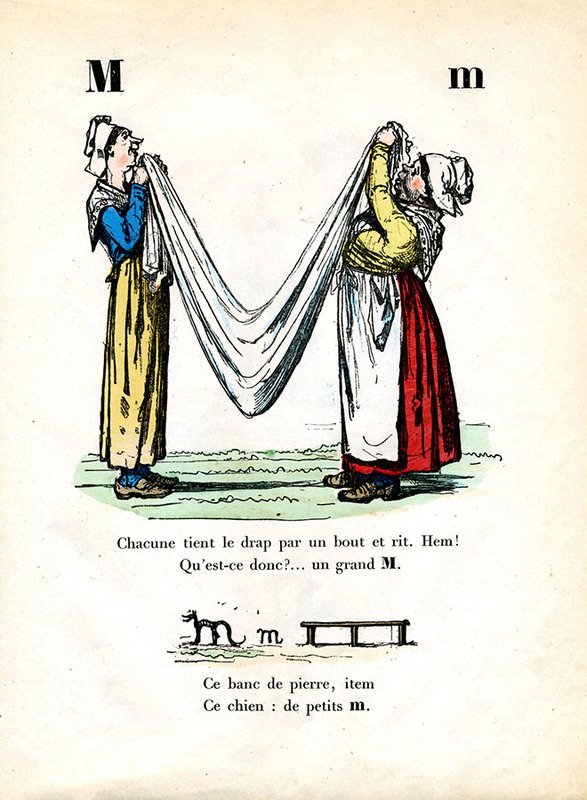
ABC Trim, alphabet enchanté. Illustrations by Bertal. France, 1861 Wikimedia Commons
Frame
A game for any number of people, which was invented by one of the creators of the chess program “Kaissa” and the author of the program for finding anagrams, Alexander Bitman. First, players choose several consonants - this will be the frame, the skeleton of the word. Then the time is noted (two to three minutes), and the players begin to “stretch” vowels (as well as “й”, “ь”, “ъ”) onto the frame to form existing words. Consonants can be used in any order, but only once, and vowels can be added in any number. For example, players choose the letters “t”, “m”, “n” - then the words “fog”, “manto”, “mantle”, “coin”, “darkness”, “ataman”, “muteness” and other. The winner is the one who can come up with the most words (as usual, these must be singular common nouns). The game can be played even with one letter - for example, “l”. The words “il”, “bark”, “yula”, “aloe”, “spruce” are formed around it, and if it is agreed that the letter can be doubled - “alley” and “lily”. If the standard “framework” has been mastered, then the task may be to compose an entire phrase with one consonant: a textbook example from the book by Evgeniy Gik - “Bobby, kill the boy and beat the woman at the baobab tree.”
Chain of words
A game for any number of players. Many people know it under the name “How to make a molehill out of a molehill,” and it was invented by the writer and mathematician Lewis Carroll, the author of “Alice.” The “chain” is based on metagram words, that is, words that differ in only one letter. The players' task is to turn one word into another with the least number of intermediate links. For example, let’s make a “goat” from a “fox”: FOX - LINDEN - PAW - KAPA - KARA - BARK - GOAT. It is interesting to give tasks with a plot: so that “day” turns into “night”, “river” becomes “sea”. The well-known chain, where the “elephant” grows from the “fly”, is obtained in 16 moves: FLY - MURA - TURA - TARA - KARA - KARE - CAFE - KAFR - MUSTER - SKAY - HOOK - ARINK - LESSON - DEADLINE - STOCK - MOAN - ELEPHANT (example by Evgeny Gik). To practice, you can compete in finding metagrams for a word. For example, the word “tone” gives “sleep”, “background”, “current”, “tom”, “tan” and so on - whoever gets the most options wins.
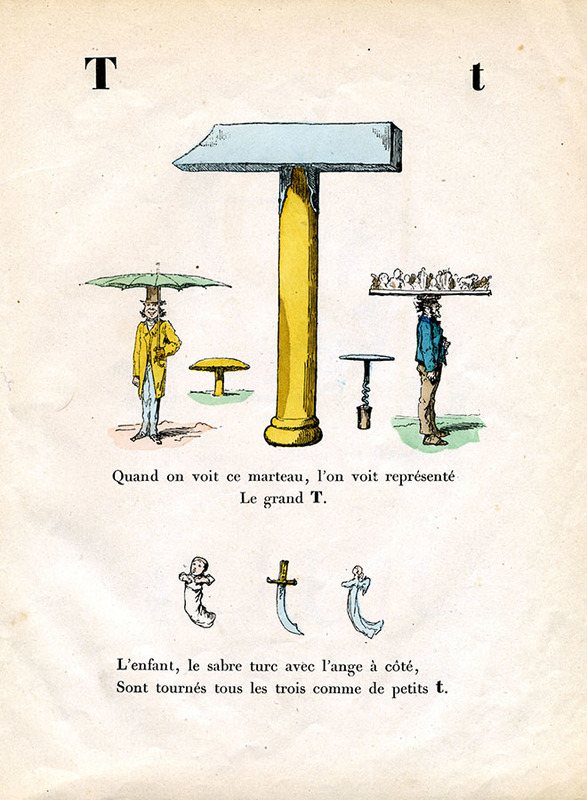
ABC Trim, alphabet enchanté. Illustrations by Bertal. France, 1861 Wikimedia Commons
Hat
A game for a company of four people, requiring simple equipment: pens, paper and a “hat” (an ordinary plastic bag will do). Sheets of paper need to be torn into small pieces and distributed to the players, the number of pieces depends on how many people are playing: the larger the company, the less for each person. Players write words on pieces of paper (one for each piece of paper) and throw them into the “hat”. Here, too, there are options - you can simply play with words (noun, common noun, singular), or you can play with famous people or literary characters. Then the participants are divided into teams - two or more people in each; Everyone’s task is to explain to their teammates in 20 seconds (or 30, or a minute - the timing can be set according to your own choice) the largest number of words randomly pulled out of the “hat”, without using the same roots. If the driver could not explain a word, it returns to the hat and will be played by the other team. At the end of the game, the words guessed by different representatives of the same team are summed up, their number is counted, and the team with the most pieces of paper is awarded the victory. A popular version of the game: everything is the same, but in the first round the players explain the words (or describe the characters) orally, in the second they show them in pantomime, in the third they explain the same words in one word. And recently a board game appeared, where you not only need to explain and show, but also draw.
"Wonderful bag"
Target:
focus on the gender of the noun when defining an object by its characteristics.
Materials: hare, carrot, cucumber, apple, tomato, bag.
Let’s tell the children something like this: “A hare came to our kindergarten. Runaway bunny, what's in your bag? Can I have a look? What is this? (Carrot.) What carrot? (Long, red.) Put the carrots on the table. And what's that? (Cucumber.) What cucumber? (In the same way we take out a tomato, apple, etc.)
Now the hare wants to play with you. He hid all the vegetables and fruits in a bag. The bunny will put his paw into the bag, take a vegetable or fruit and tell you about it, and you must guess what the bunny has in his paw. Listen carefully. It is long and red. What is this? (Carrot.) It is green and long. What is this? (Cucumber.) It is round and red. What is this? (Apple.) It is round and red. What is this? (Tomato.)"
“Who is screaming?”
Target. Ensure that children correctly reproduce various onomatopoeias. Development of the ability to onomatopoeia, as well as speech hearing.
Preparatory work. Prepare toys: rooster, chicken, cat, dog, duck, cow. Think through questions for the text of the poem so that children actively use onomatopoeia in their answers.
Ku-ka-re-ku! I look after the chickens.
Where, whack, whack! She got carried away in the bushes.
Moore - purrr! I scare the chickens.
Am-am! Who's there?
Quack-quack-quack! It will rain tomorrow morning!
Moo-moo! Milk for anyone?
Methodical instructions. You need to read the poem expressively, and while reading, show the children the appropriate toys.
